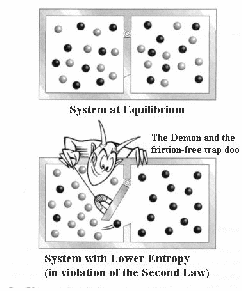
James Clerk Maxwell introduced a now-famous thought experiment that highlighted the contrast between the statistical nature of entropy and the deterministic nature of the underlying physical processes. This experiment, known as Maxwell's demon, consists of a hypothetical "demon" that guards a frictionless trapdoor between two containers filled with gases at equal temperatures. By allowing fast molecules through the trapdoor in only one direction and only slow molecules in the other direction, the demon raises the temperature of one gas and lowers the temperature of the other, apparently violating the Second Law.
Maxwell's thought experiment was only resolved in the 20th century. The key idea is that the demon itself necessarily possesses a non-negligible amount of entropy that increases even as the gases lose entropy, so that the entropy of the system as a whole increases. This is because the demon has to contain many internal "parts" (essentially: a memory space to store information on the gas molecules) if it is to perform its job reliably, and therefore has to be considered a macroscopic system with non-vanishing entropy. An equivalent way of saying this is that the information possessed by the demon on which atoms are considered "fast" or "slow", can be considered a form of entropy known as information entropy.
